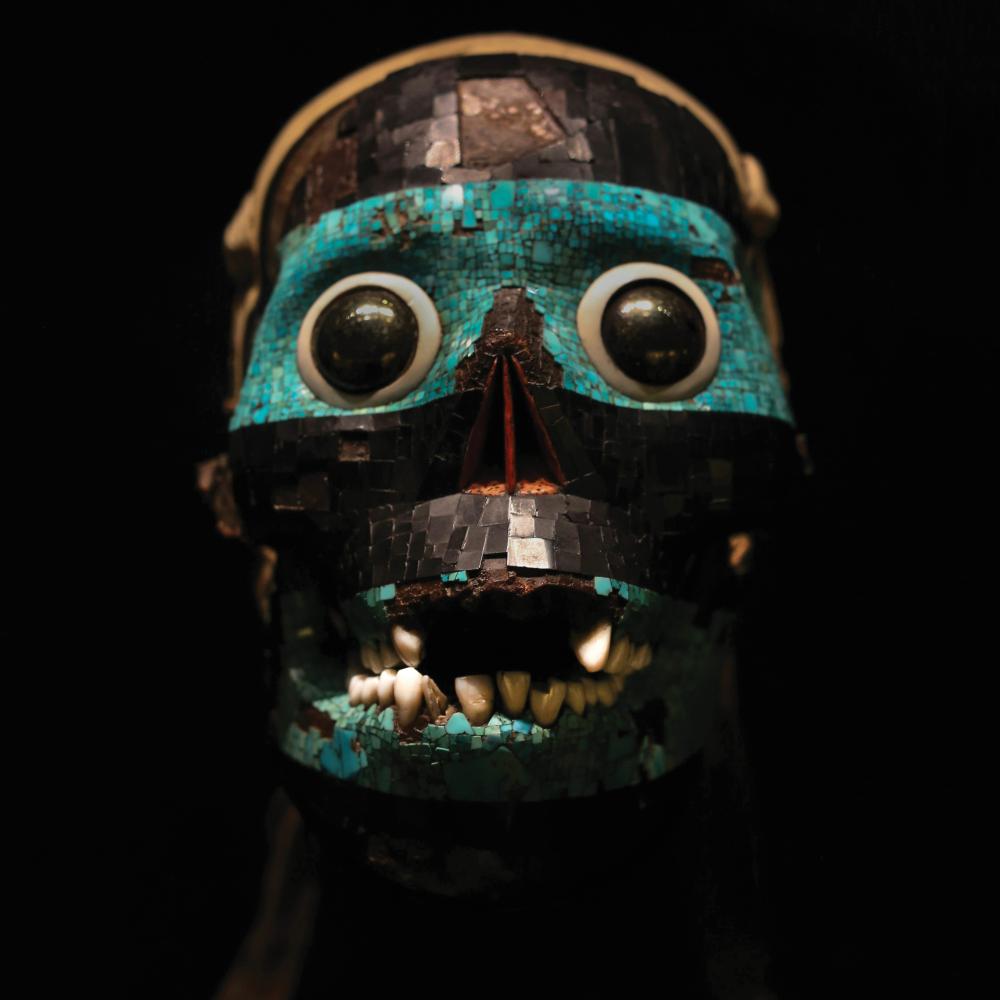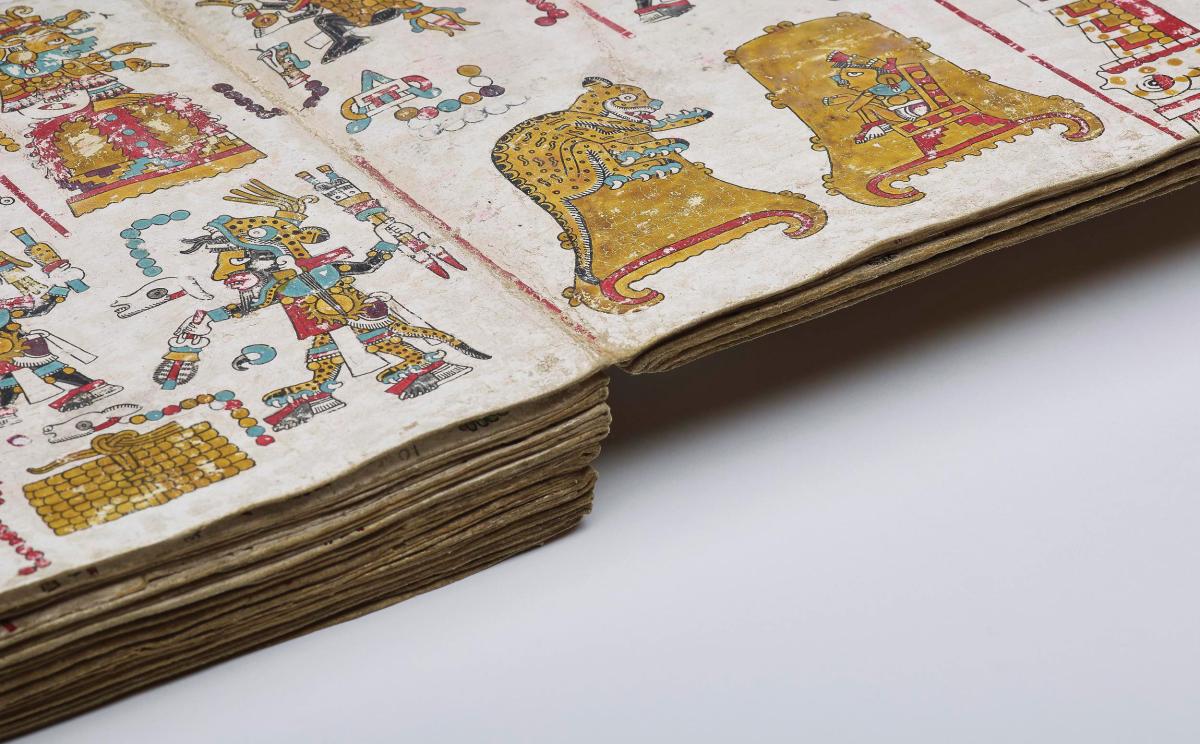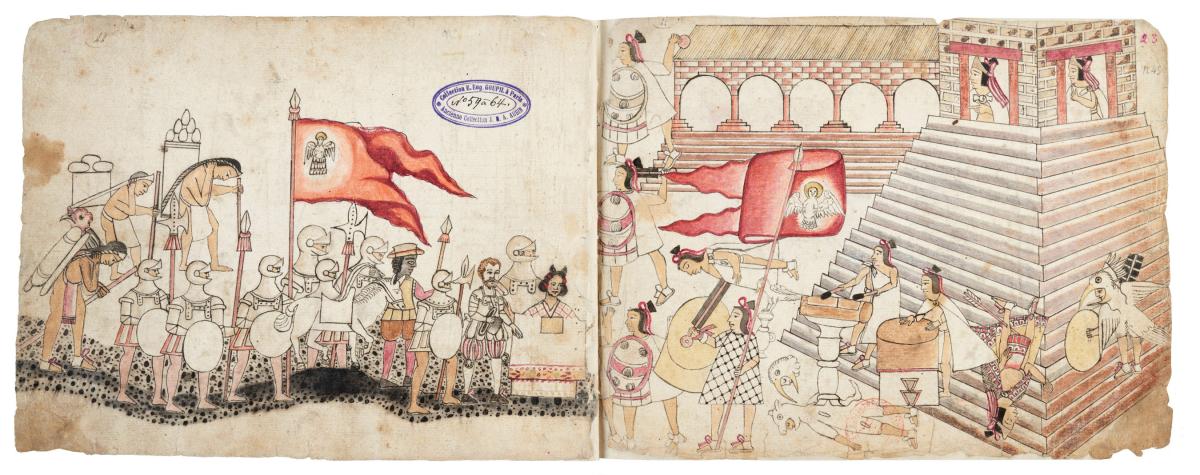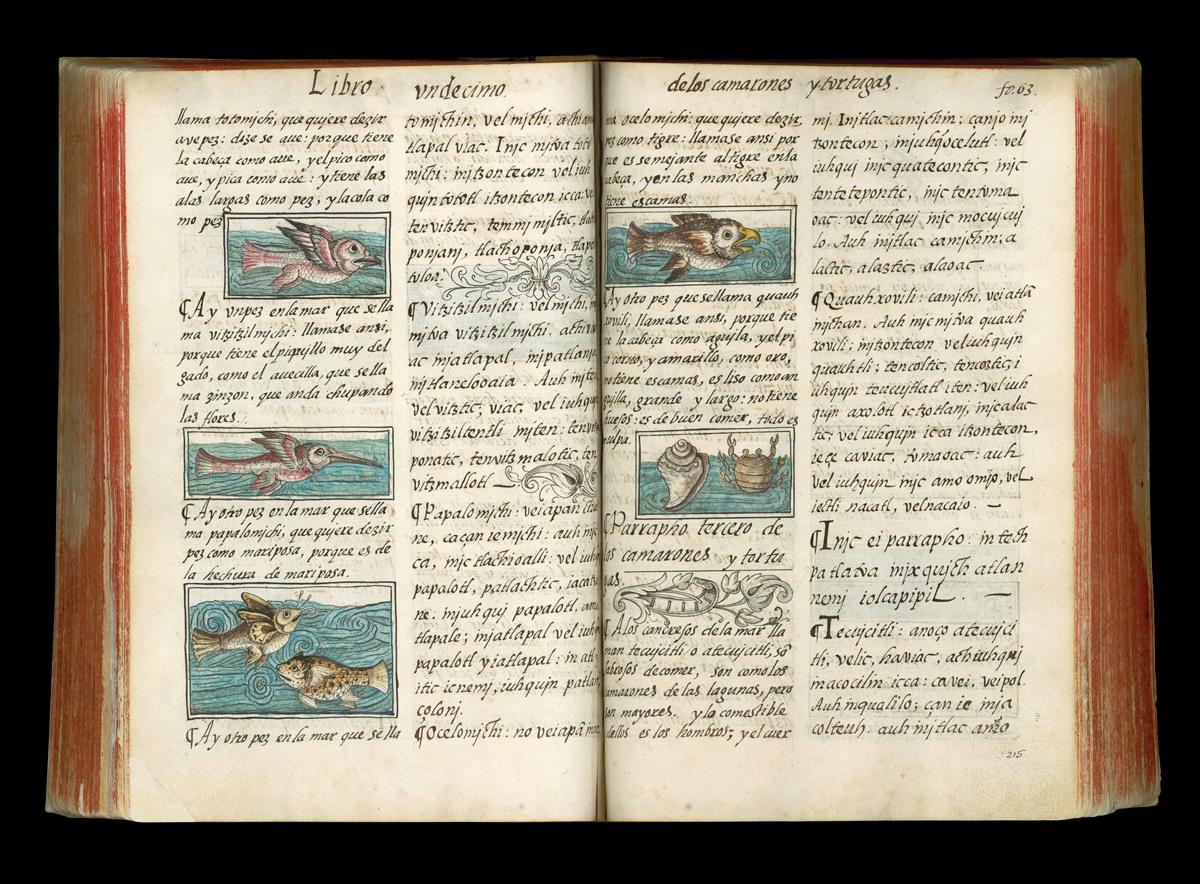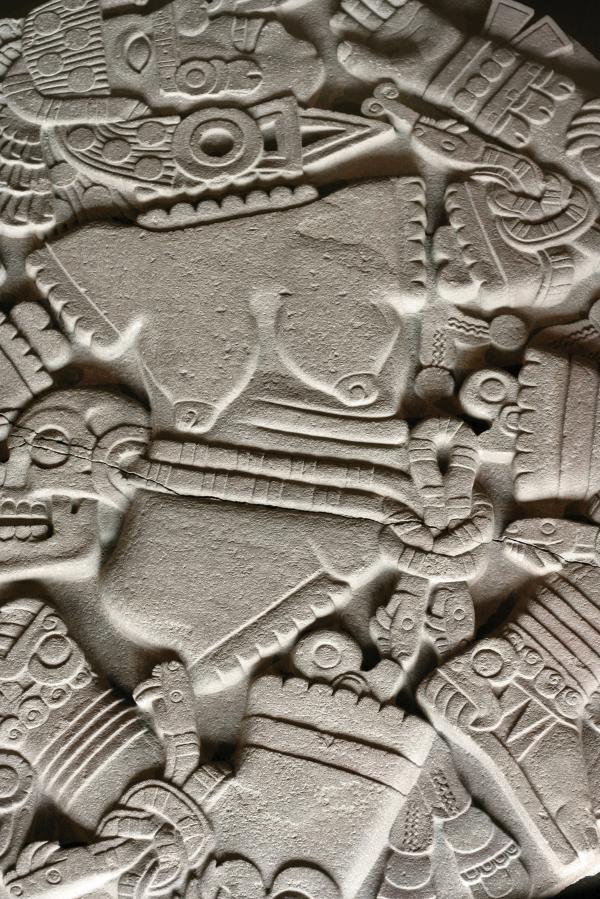In the course of my studies, I had read the old Aztec manuscript many times before I got the joke. One of the main characters in the text I was reading was named “Huemac,” or “Big Gift,” apparently because he had been a gift from the gods, left as a foundling for the local people to raise. When he grew up, he did as the gods had foreseen and caused terrible discord between two different communities. What a name for such a troublemaker, I thought to myself. Then one day, I suddenly heard the sarcasm; I considered the way a storyteller might have smiled slyly as he said to a group of young listeners, “And what do you think that one’s name was? It was ‘Big Gift!’” I should have heard it sooner. Years ago, a great man in the field of Aztec studies once looked for names as he combed through hundreds of sixteenth-century legal documents created under Spanish rule, and he found such monikers as Amichin, “She’s-not-a-fish” (for a two-year-old who did not like baths), and Quen opeuh, “How-did-he-begin?” (for a sixth child who was evidently an accident). I knew that the Nahuas—speakers of the Aztec language of Nahuatl—dearly loved a good joke, yet it had taken me a long time to hear the humor in the tale of Huemac.
By the time I did, I had been studying the language for more than 15 years and was busy at work on a book about Aztec history based closely on the sources the Nahuas wrote in their own language for their own posterity. It covered not only the Mexica (Me-SHEE-ka), the people who were dominant when the Spaniards arrived, but all the Nahuas living in central Mexico, who largely shared a common culture. By hewing closely to Nahuatl-language accounts and disregarding what the Spaniards had to say, I managed to write a book that felt quite different from the oft-told tale of Hernando Cortés-Meets-Moctezuma. People had had quite enough of the swashbuckling conquistador who left Spain’s Caribbean outpost of empire with a small fleet in 1519, scuttled his ships off the coast of what is today Veracruz so that his men could not go back, and then made his way up the mountains to what he had heard was a great and wealthy city. The high king of the Aztecs let him in as a visitor and lived to rue that choice.
But was the new version of the story really so different? The book certainly met a warm welcome. People liked it and praised it. In our modern era, everyone agreed that it was good to tell the story by relying on the Nahuas’ own words and metaphors and focusing on their perspectives. It was a mark of respect to let them speak. No one disputed that. Yet at the same time, people who were paying attention couldn’t help noticing that the events the book recounted were largely the same as the events that appeared in other books based on Spanish sources. The Indigenous texts did sometimes reveal what had been going on behind the curtain, so to speak: For instance, only Nahuatl sources tell us that during the months when Hernando Cortés’s forces were trying to bring down the mighty Aztec empire, the Mexica king, Cuauhtemoc (Moctezuma’s successor), was engaged in a vicious conflict as he worked to consolidate his power. But there was nothing in that account that changed our overall understanding of the basic facts that the Aztecs rose to power in the central valley of Mexico and then fell in the face of Renaissance Europe’s attack. In many senses, the Spaniards had gotten the story right.
Perhaps because I myself am white and not Indigenous, many non-Indigenous interlocutors did not hesitate to push me on this issue. They acknowledged that listening to the Aztecs was the right thing to do in a moral sense. But in the end, they asked, what difference did it really make? Did it change what we know about history in any important sense?
In retrospect, I think my initial answer wasn’t nearly good enough. I said that the Aztecs only appear truly human in their own writings, and not those of the Spaniards. We have grown comfortable writing histories that largely depend on Spanish sources. This is dangerous in an intellectual sense because any narrative that relies for its explanatory power on the notion that one side in a conflict is not truly human is obviously going to mislead us in significant ways. But it was only in my ongoing conversations with such questioners that I came to be able to articulate more specifically what those “significant ways” were. Why exactly had the book felt so different from the norm when people first read it?
It seems to me that there have been two distinct yet related assumptions that have profoundly affected our thinking and our research, even in recent generations. First, Nahuatl-language sources have been thought to be untrustworthy in an academic sense, insistent statements on the part of culture-bound individuals who had no interest in the wider truth. (After all—for instance—it is unlikely that Huemac ever really lived.) Second, the Aztecs have been envisioned as a people with a highly unusual culture, one that valorized death and violence and emphasized the need for mass killings in order to keep the sun in the sky. (Every school child has heard this version, so it becomes difficult to question.)
Taking these views apart and allowing ourselves to see their falsity—or partial falsity—may allow us to interpret history, to understand the well-known plot, in new ways. It is worth looking at the Nahuatl-language evidence against these long-held but ultimately insidious assumptions.
What do scholars mean when they say they study “Nahuatl-language sources”? It turns out that we often mean very different things. Mesoamerican writing is ancient. More than three thousand years ago, the Olmecs on the Gulf Coast of Mexico developed a complex calendar, and with it, a writing system surrounding 20 day-sign glyphs. The calendar and the writing (including the 20 day signs) spread both east and west, eventually influencing the rise of writing in Mayan country (in Yucatan and Central America) and in the central valley of Mexico (the basin in which today’s Mexico City is located). The Mayas developed a highly sophisticated system of writing that was both pictographic and phonetic; only in recent decades have scholars come to be able to read about 90 percent of it.
However, the writing that existed in the central valley of Mexico remained almost entirely pictographic. Priests could look at a carved or painted calendar and tell the people where they were in the march of time, or history performers could look at a long strip of paper made of bark or plant fibers, and the symbols that they saw would elicit from them stories that listeners could learn from. The symbols were a kind of mnemonic device. Very few sources from precolonial central Mexico survive today; European bonfires destroyed what the friars called the “work of the devil.” Those few existing codices and the related texts that were created in the early colonial era are very difficult for us to understand the full meaning of, for the associated utterances depended on the memories of people who have now been dead for five hundred years. Indeed, the meanings had become largely inscrutable by the mid 1500s, even to the children and grandchildren of those who had once been the keepers of the symbols. One young Indigenous man writing in the 1540s or ’50s, looking at a set of pictographic images referring to the 1440s, threw up his hands in frustration and said, “And in that year . . . a great many things happened.”
Fortunately, that same young man—like thousands of others across Mexico—was busy developing the use of another kind of writing. His name was Mateo Sánchez, and the friars had taught him the Roman alphabet (almost identical to the one that we use) so that he could learn to read the Bible, help proselytize his people, and administer the Spanish state in his village. He did those things, but he also took the alphabet home with him and, unbeknownst to the Spaniards, put it to a completely different use: He asked surviving elders to tell him the old histories that he could no longer read, and he transcribed what they said, using the Roman alphabet to sound out the words and write in Nahuatl. Perhaps partly because of their frustration with their fading comprehension of the old pictorial writing system, Sánchez and his peers took to the imported phonetic system with alacrity. They taught it to their own sons and younger brothers and occasionally even to girls, and alphabetic writing soon took on a life of its own among the Indigenous people of colonial Mexico.
Given the complex history of writing in Mesoamerica, it comes as no surprise that scholars have studied very different aspects of the writings of the Nahuas. Some, mostly art historians, study the glyphs as found in the handful of surviving precolonial books or the larger number of colonial drawings that contain some of the glyphs. Others, like the late James Lockhart, a superb American historian, studied primarily the legal documents produced by Nahuas in alphabetic Nahuatl as they put the new writing to use in the business of life under the Spanish state—creating wills, selling land, or producing petitions. The late Miguel León-Portilla, a world-renowned Mexican scholar, studied the materials that the Indigenous students created as they worked together with the Spanish friars who were their teachers. More recently, anthropologist Louise Burkhart has turned the tables, asking how some of the Christian materials that the Nahuas produced actually represent their own perspectives as they engaged with the newly imported ideas; the Spaniards were not in as much control as they thought they were.
What I wanted to do was to work for a while exclusively with the sources produced not only by Nahuas, but also for Nahuas, without regard to the Spanish world. The best examples of such work are the xiuhpohualli (shoo-po-WAH-lee) or “yearly accounts,” the histories written down based on readings of the old mnemonic devices—readings that were still possible in the earliest decades after the Spaniards arrived. Such texts were widely shared among networks of friends and relatives, and each person who copied one down could add to it, embellishing certain segments and cutting others. Some individuals maintained an ongoing xiuhpohualli history, recording the events of their own day. Eventually, the writing style changed. For instance, people no longer remembered that they were supposed to break into dialog to express opposing schools of thought; and they no longer knew that they should describe leading figures with color and splash. Instead, the histories of later years became increasingly terse.
The copied-out older segments, however, remained very detailed. They were also very difficult for outsiders to understand. It was these texts that earned the reputation of being inaccurate ramblings designed to promote the teller’s (or writer’s) own community. It is certainly true that the Nahuatl histories were narrated according to their own principles, not Western ones. Here, for instance, is a description of the ending of a major war:
The Mexica were at Chapultepec for forty-two years. In the forty-third, in the year One Rabbit, they were despoiled. Huitzilihuitl, the Mexica king, was brought to Culhuacan, together with his daughter, Chimalaxochitzin. To Xochimilco were brought the priest Cimatecatl, and Tezcacohuacatl, and Tozpaxoch. To Maltatzinco were brought a number of women. To Cuernavaca were brought Cohuatzontli and some women. To Chalco were brought Huitziltecatl and some women.
And the litany goes on for many more lines.
When I was first faced with material like this, I sighed inwardly, wondering what I was supposed to make of it. Why had they taken the time to pass down such minutiae to future generations? Since I could not understand it, I sometimes retreated to boredom or to condescension, as other scholars had before me. My eyes glazed over, and I would tell myself to look for a different, “more interesting” or “more important” part of the text. Only little by little, once I had seen dozens of stories about wars, was I able to understand that the fate of high-born prisoners (especially of priests and women) was extremely politically significant. The history teller was making a point based on data. Anyone could simply say, “We lost badly,” or “They barely were able to squeak out a victory,” or alternatively, “We crushed them,” or “We won, but everyone knew we squeaked by and wouldn’t be able to hold them in subjection very long.” Those, however, are just assertions, subject to doubt. On the other hand, a sort of chart of who was taken prisoner, and where they were taken, and whether they went to be sacrificed or to become servants or even wives was something else—that was their version of evidence, a proof or demonstration, either of the level of their defeat and resulting suffering, or of the degree of their power and ensuing victory (depending on who was doing the telling). Because the text did not overtly discuss the power politics of the valley as a whole, it might at first be perceived as a parochial or self-pitying story of the trials undergone by the narrator’s people; but once a reader grasped its “grammar,” so to speak, it illuminated the history of the valley rather remarkably. About six generations before the arrival of the Europeans, the Mexica (who were later to dominate the Aztec world) had suffered a defeat so devastating, so complete, that all their leading noblewomen had been distributed to other city-states as prisoners. That experience had galvanized them; as long as memory of it lasted, they would never allow themselves to be so vulnerable again.
We might wonder why scholars had not been more patient with these sources, more willing to listen to them carefully, especially in the recent era of multiculturalism. Perhaps part of the answer lies in the fact that there is a significant language barrier: It takes a long time to learn to read Nahuatl well enough to be able to understand the sources deeply. But humanities scholars often take on such tasks. So perhaps part of the answer lies in the horrendous reputation of the Aztecs. In essence, this narrative hadn’t changed much since the days when the Spaniards expressed their horror, although the tone had grown far less judgmental. Based largely on Spanish sources as well as the archaeological excavation of the Templo Mayor (the Mexicas’ most important religious site), a postwar generation of anthropologists had worked out that according to the Aztec “cosmovision,” they had no choice but to sacrifice hundreds of people regularly, so that their blood might feed the gods; they were convinced that if they did not, the sun would not continue in its track. Studying what the Nahuas wrote about such matters seemed a less than appealing prospect.
But doing just that turned out to be important. The Nahuatl-language texts written “off the radar” of the Spaniards do not express any such blind fatalism or any love of death. Archaeologists tell us that people on all the inhabited continents at early points in their history seem to have practiced occasional human sacrifice, often of prisoners of war. Indigenous Americans were no different. The Mexica, who rose to lord it over all the other Nahuatl-speaking people in central Mexico by the late 1400s, began their political lives as underdogs. At first, they no more had the power to sacrifice hundreds of people than they had the power to fly; nor did they speak of a wish to do so at that time. Their histories tell us that, as their power increased, they weaponized the practice of wartime sacrifice in order to terrorize their neighbors (and thus, they reasoned, protect themselves). They began to sacrifice ever greater numbers of people at monthly ceremonies. Their histories tell us that they would kidnap people from an area they hoped to add to their empire, have them watch the worst of it, and then let them run home to their families. The Mexica knew they would advise joining the Aztec empire willingly; they would explain to their people that if they attempted to fight, they would face the risk of having dozens of their young people taken prisoner as potential sacrifice victims. “In this way, they were undone,” said one Mexica commentator.
The Nahuas—all of them, not just the Mexica—did believe that the blood of the sacrificed went to feed the gods, and they honored them for giving their lives on behalf of other humans. But there is no evidence in the Nahuatl sources that the Mexica believed they needed to sacrifice huge numbers to keep the gods happy. On the contrary, they bemoaned the excessive deaths that war caused. By their own admission, they had a propaganda machine, and perhaps it worked a bit too well. Some glyphic sources showed vast numbers of deaths: in one case, four of a number called xiquipilli (shee-kee-PEE-lee), pictured as a bag of grain or stones and understood to mean 8,000. They had a base-twenty system, and thus a symbol for 20, for 400 (20 x 20), and for 8,000 (400 x 20). People looking at the glyphs years later said in all seriousness that in one ceremony, the Mexica had killed 32,000 people. But the number xiquipilli was a culturally imbued, symbolic number meaning in effect “an impressively large number.” One serious alphabetic source recounts that in the early 1500s, for a celebration of the close of the all-important, 52-year calendrical cycle, Moctezuma said that he himself would provide 20 sacrifice victims, and he would personally advise the king of Texcoco to do the same, for an impressive total of 40. Those 40 deaths are to be lamented, but they are a far cry from the 32,000 that the West has loved to believe in.
Without knowing what the written sources say, we can look at the elements of the Templo Mayor, where the sacrifices occurred, and imagine that the people who built such a place were monsters. The famous Coyolxauhqui (Ko-yol-SHAUW-kee) Stone shows a dismembered woman, the sister of the god Huitzilopochtli (Weetz-eel-oh-POCH-tlee), whom he threw from the sky in a fit of rage. People have looked at it and thought with horror of the misogyny and the love of violence it seems to be a sign of. But several surviving Nahuatl-language versions of the story give a different impression. Coyolxauhqui was the eldest daughter of a goddess and expected to inherit her mother’s power. When she learned that her mother had grown pregnant again and expected to give birth to a new heir, she became enraged and planned to kill her parent. Fortunately, the baby was born in time to save Mom, coming forth as a full-grown warrior. In his anger and in defense of his mother, he threw his sister to earth, where she lay dismembered. All nature was horrified at what had happened. There was total silence; “the birds left” the valley.
People listening to the story around the evening cooking fire would have heard a tale of the dangers of the world in which we live, dangers brought about by envy and anger. Some would have thought Huitzilopochtli did right to defend his mother and his position. He, after all, became the tutelary god of the Mexica, and they wanted him to be strong. On the other hand, some would have thought that the moral of the story was that violence breeds violence, and that such acts are alienating even to nature, for who would want to chase away the very birds?
When we hear the Aztecs speak, we come to understand them better. On one level, this is valuable in and of itself. Every culture group deserves to be heard, and descendant communities should be allowed to set down the burden of their ancestors’ reputation.
But we also grow wiser on another level. In the past, we have been content to accept that the Mexica were monsters whose culture encouraged them to do terrible deeds every day. That in turn allowed us to believe that all the other Nahuas hated and reviled them, and that all were delighted to turn against them and side with the Christians. (Older people will remember that some even said the Aztecs worshipped the Spaniards, though it has been a while since many people believed that.) According to this reasoning, the conquest was implicitly a very good thing, one that we should all be rather glad occurred. In fact, however, the Nahuas were deeply divided when the Spaniards arrived, for although many resented the Mexica, many others admired them or were intermarried with them or hoped to join them, and none were immediately convinced that the strangers offered a better deal. Even those who did side with the Spaniards almost immediately began to express pain in the histories that they wrote, as the newcomers made horrible and unreasonable demands. Military realities caused the Aztec world to crumble, not the culture of the Mexica; few Nahuas were happy about it.
Once the Nahuas become real to us—living their own specific history and recording it in reasonable ways, engaging in political and military struggles and making both friends and enemies along the way, and telling complex stories that reveal normal human psyches—we must face that we ourselves have accepted an almost cartoonish version of the past. We can do better. It isn’t that we had the series of events wrong; but we did have the explanations wrong.

